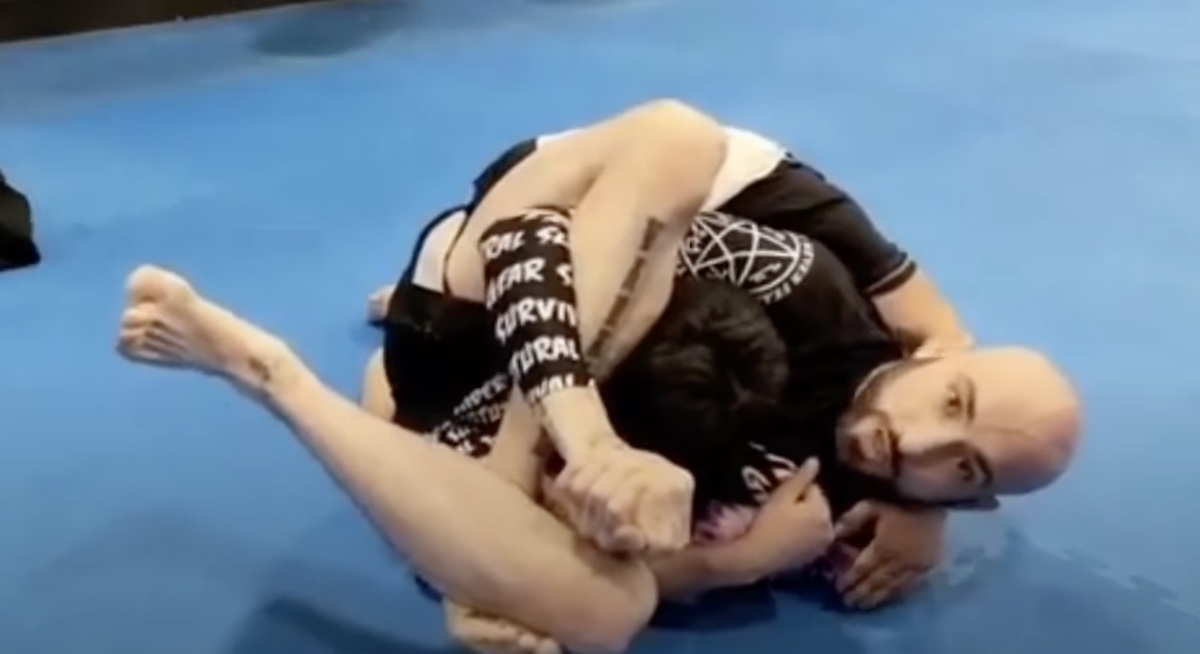Buggy Choke – The Latest BJJ Fade Technique

The buggy choke is the latest fade technique to hit the Jiu Jitsu world. Since it was introduced, the buggy choke has been attempted in everything from Jiu Jitsu competitions and MMA.
It has caught on like wildfire and now just about everyone is trying to do the buggy choke. Since everyone is going for it, a breakdown of the buggy choke seems to be needed.
Here is everything you need to know about the buggy choke. From who invented it, how it works, and important details you’ll need to remember for locking it in.

Who invented the buggy choke?
There are two different people that claim to have invented the buggy the choke. The first was a Ralph Gracie white belt named Austin Hardt that showed after tapping all of his teammates with it.
Austin and his professors claim that he came up with the move in 2016. After tapping all of his teammates, Hardt uploaded a buggy choke instructional and the BJJ community loved it.
Then after the buggy choke first started getting popular, black belt named Jacob Sebastian Magee claimed he invented the buggy choke. Claiming that he started doing it 5 years before Austin’s video was uploaded to Youtube.
There’s no way to confirm Magee’s claim, but either way the buggy choke has become quite popular.
Now, there are currently three different variations of the choke and many variations will be developed in the future. The choke has now been pulled off multiple times within both MMA and BJJ competitions.
How does the buggy choke work?
The buggy choke is basically a variation of a reverse triangle choke from bottom side-control. It has caught a lot of grapplers off guard, because having side-control is one of the most dominant positions in grappling.
In this choke, you lock up your triangle with your arm in. Your arm blocks off blood to one side of your opponent’s neck and your legs block off the other part.
It comes on quickly and before your opponent realizes it, they’ll have to tap or go to sleep.
Ruotolo bros buggy choke
The Ruotolo brothers buggy choke from on bottom in side-control starts with you getting on your side and turning into your opponent. While you’re turning, you also bring your outside arm to the other side of your head.
It may feel like you’re giving up an arm triangle, but if you stay on your side, you should avoid the choke. When you turn in, your opponent will naturally react by trying to flatten you back down with force.
This is the reaction you want for your opponent to get as close as possible to you. If they’re really strong, you can cup their shoulder and lift up to relieve some of the pressure.
You’re going to stay on your side and bring your outside leg to your arm. Taking an underhook right under your knee to make the buggy choke tight.
Make sure to do a side crunch when grabbing your leg to keep your opponent’s head in place. Now, to lock in the choke, Gable grip your hands, triangle your legs, and pull your opponent in as you squeeze.
Buggy choke variation #2
The original buggy choke that Austin Hardt came up with has exactly the same steps as the Ruotolo brother’s version. But Austin’s original buggy choke, he doesn’t triangle his legs or locks his hands together.
You start out the same in side-control on the bottom and frame on your opponent to get on your side. Pushing on them as you bring your outside arm to the other side of your head.
Your opponent will instinctively try to smash you back down to the mat. When they do this, stay on your side and bring your outside foot to your hand.
Grab the top of your foot and pull down on it to try and get the finish. The Ruotolo brother’s version is better with triangling your legs and palm grips, but the original is effective.
Buggy choke variation #3
There is another version of the buggy choke that was developed, that’s done turning away from your opponent. Austin Hardt also developed this version to attack the buggy choke from both sides.
For this one to work, you can’t let your opponent establish control of your inside. If they control this arm, then you won’t be able to do this buggy choke variation.
A good way to start this variation is to do the first steps of the normal buggy choke. Frame on your opponent’s neck and elbow escape out to make space.
When you make this space, you can pull your inside arm away and turn to your outside hip. Generally it’s a critical error to turn away from your opponent, but you’re using it as bait.
They will instinctively follow you and try to smash you to the mat. Your inside arm is going to go over your opponent’s neck as you’re basing on your outside elbow.
Now, bring your inside foot to you hand and grab your foot as you sit up. Your opponent will base out with their hand to defend this, which allows you to triangle your legs together.
To finish, scoop your hips, connect your hands, and squeeze to get the tap.This video demonstrates the last two buggy choke variations detailed above.
How to defend against the buggy choke
BJJ grapplers have been getting tricky with the buggy choke, so you really have to watch out for it now. Here are some techniques that you can use to defend against the buggy choke.
Drive your head up
When your opponent brings their arm over your head, that is a clear sign that they’re going for the choke. If you keep your head down, this will allow them to continue their buggy choke set up.
But as you see them bring their arm over, you need to drive you head up towards their head. Driving your head up will create more space and prevent your opponent from continuing their set up.
Block opponent’s hip
If your opponent is already locking in their buggy choke, you have to react quickly to prevent being submitted. What you can do to try and defend it is block their hip using your elbow.
As you block their hip, you’re going to drive your head forward. Doing this will help open space between your neck and shoulder, which will take off the pressure.
Bend opponent’s neck
This is your last line of defense when your opponent has their buggy choke locked in. You’re going to do the same defense as the second option with extra detail added.
Take your far elbow over your opponent’s head and push it back into their neck. This bends their head away from their body, which makes their body unaligned with their head.
It is extremely hard to finish chokes when your head and body aren’t aligned. This video demonstrates the details of all three of these defenses.
Tips to remember for doing the buggy choke
The buggy choke is a great move to add to your arsonal, but you will need to get the details down. Here are important tips that you will need to remember when going for a buggy choke.
- Get on your side: For any variation of the buggy choke to work, you must get on your side. If you stay flat on your back, your opponent will get pressure on you and prevent the choke.
- Clear the head: When you do an elbow escape to make space, your arm needs to clear your opponent’s head. Your tricep needs to press down on the side of their neck as you stay on your side.
- Side crunch: Before you try to bring your leg over, do a side crunch to push your opponent’s head down. This will make it easier to underhook your leg and help make the choke tight.
- Arm under knee: To make the buggy choke tighter and harder to escape, make sure to underhook at the crook of your knee. Picture doing an uppercut to shoot your arm under your knee.
- The Locks: To finish the original buggy choke, you just grab your foot, but the locks make it tighter and harder to escape. After under-hooking your leg, triangle your legs, and Gable grip your hands together to make your choke even tighter.(Also harder to escape)
- The finish: You finish a buggy choke just like you would a traditional reverse triangle choke. Try to turn onto your outside hip as you squeeze in to get the most pressure possible.
- Base on elbow: Also, when doing the buggy choke variation on your outside hip to base on your elbow. If you do not base on that elbow, your opponent will flatten you out or even go for a back take.






